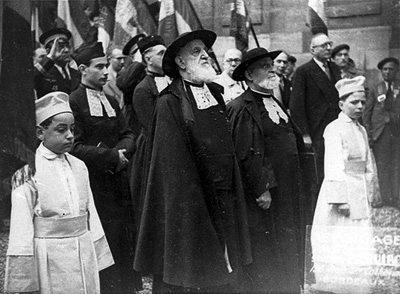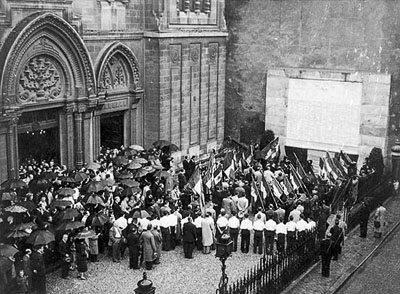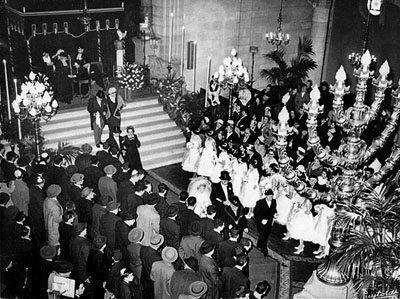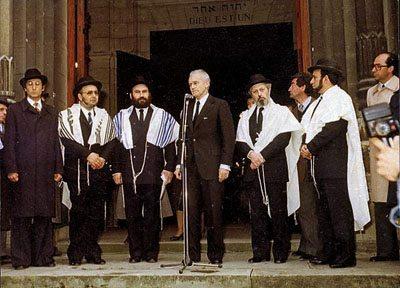The Great Synagogue in Bordeaux, France
Haim F. Ghiuzeli
The building of the Great Synagogue of Bordeaux was inaugurated on September 5, 1882 – 21 Elul, in the presence of the Great Rabbi of France Lazard Isidore (1813-1888), Oury, the rabbi of Toulouse, and the chief rabbi of Bordeaux, Simon Levy. This new building replaced an earlier synagogue that functioned on Causserouge street, within the old Jewish quarter of Bordeaux, from 1812 until June 27, 1873, when it was destroyed in a fire. The Jewish community of Bordeaux decided immediately to build a new edifice; however, the narrow streets of the old Jewish quarter were judged inappropriate for the new project and consequently a new address was chosen on Labirat street. The first plan of the new building was drawn by Andre Burguet (1821-1879); it was followed by Charles Durand (1824-1891) who finalized the architectural design in 1880. The total costs of building the synagogue mounted to over 660,000 francs, a large amount of money at the time. The founding of the new synagogue was financed from the money received after selling the grounds of the former synagogue on Causserouge street as well from donations by members of the Sephardi community of Bordeaux, among them a special mention should be made of the Pereire family of bankers. Additional contributions were received from the Municipality of Bordeaux and the government of France. When it opened in 1882, the Synagogue of Bordeaux was the largest in France.
The general design of the synagogue reflects the ideas of Andre Burguet, an architect whose approach favored combining elements typical of the Romanesque and Byzantine art, an eclectic style that was fashionable with many synagogue builders all over Western and Central Europe during the latter part of the 19th century. Burguet’s design comprises two symmetrical towers situated at the flanks of the western façade, strongly evocative of the bell towers found in Christian churches. The towers were eventually kept by the second architect, despite opposition from certain members of the community, who believed that the building of the new synagogue was too similar to a church. Charles Durand added a touch of Orientalism to the original design and also created an impressive perspective towards the western façade from the adjacent street. The Oriental motifs were interpreted as a hint to the Iberian origins of the local Sephardi community, but Durand did not adopt the Moorish style that was favored in many synagogues built during the same period in the eastern regions of France and elsewhere in Europe. The building of the new synagogue was quite different from that of the former synagogue on Causserouge street that combined elements of neo-classicism with what was thought then to be motifs of biblical inspiration.
The western façade, probably the most impressive section of the building, has two symmetrical towers at its sides. According to the original plan, the towers should have been crowned by octagonal bulbs, an element that has never been executed because of opposition from the community members, who fearing a too close resemblance with a church, refused to allocate the funds required to accomplish this architectural element. The middle section of the façade has three portals at its center. They are topped by pointed arches with tympana decorated with motifs taken from the old building of the synagogue, like palm trees over the lateral doors and a seven branch candelabrum (menorah) over the central door. On top of the portals there are three narrow windows with the central one higher and larger that the lateral ones. The central window is duplicated on each of the lateral towers. All windows’ tops boast smaller round windows typical of Oriental architecture as interpreted in Europe during the 19th century. The central section of the western façade is dominated by a cornice with the Tablets of Law at its highest point.

Rabbi Isaie Schwartz, Chief Rabbi of France, with Rabbi Joseph Cohen, Chief Rabbi of Bordeaux, at the ceremony in memory of Holocaust victims. Synagogue of Bordeaux, 1949. The Oster Visual Documentation Center, ANU – Museum of the Jewish People. Courtesy of Sarah Cohen, France

Unveiling the plaque in memory of Holocaust victims. Synagogue of Bordeaux, 1949. The Oster Visual Documentation Center, ANU – Museum of the Jewish People. Courtesy of Sarah Cohen, France

The wedding ceremony of Denise and Raoul Lokiec. Synagogue of Bordeaux, 1960’s. The Oster Visual Documentation Center, ANU – Museum of the Jewish People. Courtesy of Sarah Cohen, France

Jacques Chaban-Delmas, Mayor of Bordeaux (center). with community rabbis. Synagogue of Bordeaux, 1985. The Oster Visual Documentation Center, ANU – Museum of the Jewish People. Courtesy of Robert and Monique Tzoukermann, Israel
The interior of the synagogue of Bordeaux is one of the largest in France with a length of more than thirty meters and a total capacity of 1,500 sitting places. The prayer hall is preceded by a small lobby from which it is possible to access the women section located at the first floor and the prayer hall, separated from the entry hall by glass doors. The prayer hall is divided into seven bays; the galleries serving the women section are located at the first floor and are supported by two rows of metallic columns produced by the Eiffel ateliers in Bordeaux. The Holy Ark is located inside a niche at the eastern end of the prayer hall. The Ark is decorated with two columns covered in bronze and was intended to be a replica of the Holy Ark of the former synagogue on Causserouge street. Its ornamentation comprises many elements of Judaic symbolism, like ten panels suggesting the Ten Commandments, and another square panel with twelve colored stones symbolizing the twelve tribes of Israel in resemblance to the ephod of the high priest of the Temple of Jerusalem. The teba is located at the center of the prayer hall, in accordance with the traditions of the Sephardi communities of western France. A seven branch Menora dominating the prayer hall is located close to the teba.
Of special importance among the many decorative elements is the Magen David (The Star of David). In fact, the synagogue of Bordeaux was the first synagogue in France to display this motif. It can be found in many places, both at the exterior of the building, on the western façade, just under the Tablets of Law, and at the interior where it features on the floor, on the stained glass windows and on some arches.
During the Second World War the synagogue was desecrated. The German army used the synagogue as a prison from which many local Jews were deported to Nazi concentration camps. In 1944 the furniture was destroyed and pillaged by French Fascists.
The restoration work of the synagogue continued through the earlier part of the 1950’s. The interior was refurbished according to the original plans of Charles Durand and in 1956 the synagogue returned to its initial aspect. The names of the local Jews who were murdered during the Holocaust are inscribed on a memorial wall located in the courtyard of the synagogue.
The building of the synagogue of Bordeaux was recognized as a historical monument on July 20, 1998. As of 2000 the exterior of the synagogue is illuminated during the nights. The synagogue of Bordeaux serves the local Sephardi community.
Address:
Synagogue de Bordeaux
8, rue du Grand Rabbin Joseph Cohen
Bordeaux
France
Phone: 31-5-56-91-79-3



